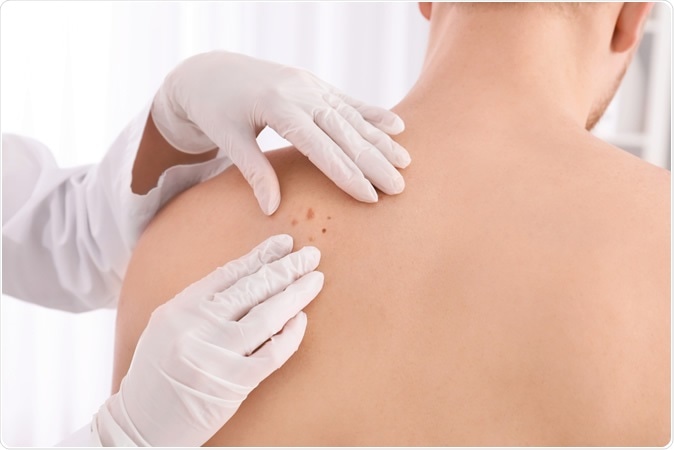Earlier studies have shown that men with non-heterosexual preferences have higher rates of both indoor tanning and skin cancer compared to heterosexual men. On the other hand, women in this category have equal or lower rates compared to their heterosexual peers. Yet no study had addressed the rates of skin cancer in the various categories of these sexual minority groups.
The current study is an attempt to do this.

Image Credit: New Africa / Shutterstock
The study
The researchers designed a cross-sectional study using data from the Behavioral Risk Factor Surveillance System (BRFSS) over the period 2014 to 2018. This population included almost 850,000 adults who reported their sexual preferences.
Of these, over 350,000 were heterosexual men and over 460,000 heterosexual women. Over 7,500 gay men and 5,300 lesbians were included, as well as over 5,000 bisexual men and 9,400 bisexual women.
They also reported the occurrence of skin cancer at any point over their lifetimes so far.
The results
The researchers found that there was no overall difference in the odds of skin cancer prevalence with sexual preference. However, when studied by the group, the odds of skin cancer were 26% higher in gay men and 48% higher in bisexual men compared to heterosexual men. With women, skin cancer was 22% lower among bisexual women but equal with lesbian compared to heterosexual women.
Limitations
The study has several limitations. For one, all US states were not covered. Secondly, the diagnoses were self-reported, which may affect the accuracy of the data. Thirdly, surveillance biases may have been present since skin cancer diagnosis depends on skin examination, which is significantly less common among sexual minorities. Fourthly, information on confounding factors like ultraviolet exposure, use of skin protection, skin type, HIV status and presence of immunosuppression, is conspicuously lacking.
Infections with the human papillomavirus (HPV) are also associated with skin cancer and are highly prevalent in sexual minority men.
An essential aspect of this report is its acceptance of sexual minorities as a permanent inborn sexual identity. This should be reconsidered.
Going to the roots
Gender dysphoria, also called gender identity disorder, is a condition in which individuals feel uncomfortable with the body they were born with, and that they should have been born with the other sex or that they are the other sex. The rise of the current LGBTQ movement has much to do with the way such children are cared for today.
This is supported by a “small but rather solid, strikingly consistent body of research” that shows at least 80%, and perhaps as much as 90%, of children with gender dysphoria, eventually desist, or grow up as cisgender rather than transgender.
This has been consistently documented since as far back as 1972. It is also worth noting that even children with apparently severe gender dysphoria desisted at the same rate as children with milder forms of the disorder.
Today, many clinicians are going the “gender-affirming” route – if a young child keeps saying he or she wants to be and feels like the opposite gender, it is accepted as being prima facie evidence of transgenderism, and the child is socially transitioned therewith.
In light of the above studies, this is a dangerous route. Moreover, since gender identity is learned and reinforced by the family and social environment (in the right sense), early social transitioning will only reinforce gender dysphoria before the child actually has a chance to come to terms with his or her actual gender identity.
Granted, a small minority of such children will need more help and specialized expertise to thrive. However, this should not be an excuse for laziness or impatience, and least of all for medical treatment given for the sake of political expediency.
Parenting and social guidance is a crucial part of helping children grow up in an often unsafe and confusing world. Adding unnecessary confusion about gender is generally the last thing that children would need or even want. Common sense, love, and a good balance between being accepting and being unduly permissive are required to help children and adolescents navigate the minefields of today’s so-called gender identity crisis and to grow up happier and more confident.
Implications
With a rapidly increasing list of health conditions associated with minority sexual preferences, it is strange that these are not recognized to be high-risk medical conditions rather than variants of normal sexual orientations. This issue may be unique to the area of sexual preferences because with most other high-risk lifestyle conditions the medical advice would be to modify the lifestyle rather than to live with it.
This study is no exception. It brings the medical community face to face with the fact that gay and bisexual preferences are associated with higher rates of indoor tanning and skin cancer. This is in addition to the already documented horrifying high rates of suicide, mental health issues including depression, substance abuse, smoking, sexually transmitted disease, and HIV, not to mention stigma and discrimination.
Because of this, public health authorities should take into consideration the fact that gender identity is learned, unlike DNA sex. In an environment where the toddler’s longing to wear his sister’s clothes is not taken as being a sign of his future sexual preference. Still, as the normal curiosity of a child for new experiences, children can be reared normally and safely to fulfill their biologically-encoded gender identity in the overwhelming majority of cases, without social and interpersonal conflict.
In the minority who persist in their trans identity, community health education to prevent high-risk behavior, and attempts to detect and manage health conditions including skin cancer, will become necessary. For instance, sunless tanning avoids exposure to cancer-inducing ultraviolet lamps and should be advocated among all groups.
Journal reference:
Singer S, Tkachenko E, Hartman RI, Mostaghimi A. Association Between Sexual Orientation and Lifetime Prevalence of Skin Cancer in the United States. JAMA Dermatol. Published online February 12, 2020. doi:10.1001/jamadermatol.2019.4196